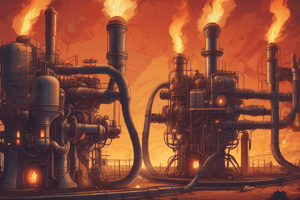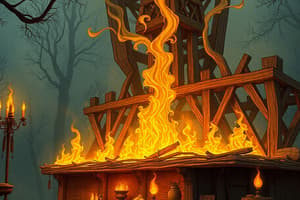Podcast
Questions and Answers
Explain how the energy dynamics in combustion create a positive feedback loop that sustains a fire.
Explain how the energy dynamics in combustion create a positive feedback loop that sustains a fire.
Once the activation energy is achieved, combustion releases energy, which then overcomes the activation energy barrier, continuing the fire.
Contrast pyrolysis and combustion, explaining the role of oxygen in each process.
Contrast pyrolysis and combustion, explaining the role of oxygen in each process.
Pyrolysis occurs in the absence of oxygen to char materials, while combustion requires oxygen to mix with oxidative components for burning.
Describe how ground fires, particularly peat fires, contribute significantly to global warming.
Describe how ground fires, particularly peat fires, contribute significantly to global warming.
Ground and subsurface peat fires release large amounts of carbon stored in the soil, acting as major contributors to greenhouse gas emissions and global warming.
Explain the link between post-fire hydrophobicity and increased soil erosion.
Explain the link between post-fire hydrophobicity and increased soil erosion.
Describe why climate is one of the ultimate controls on wildfires.
Describe why climate is one of the ultimate controls on wildfires.
How do flammable non-native grasses transform ecosystems and increase fire frequency?
How do flammable non-native grasses transform ecosystems and increase fire frequency?
Differentiate between the intrinsic and extrinsic properties of a fuelbed and give an example of each.
Differentiate between the intrinsic and extrinsic properties of a fuelbed and give an example of each.
Explain how understanding 'fire behavior' helps in wildfire management and control.
Explain how understanding 'fire behavior' helps in wildfire management and control.
Describe how remote sensing land surface data contributes to our understanding of pyrogeography.
Describe how remote sensing land surface data contributes to our understanding of pyrogeography.
Explain why ‘flammability’ is a key factor influencing biome boundaries.
Explain why ‘flammability’ is a key factor influencing biome boundaries.
Flashcards
What is fire?
What is fire?
A rapid oxidation reaction producing heat, light, and chemical products; visible effect of rapid oxidation between oxygen and fuel.
Ignition temperature
Ignition temperature
The temperature a fuel must reach for combustion to occur and sustain the fire, needs heat, fuel and oxygen.
Lightning as ignition
Lightning as ignition
Natural ignition source; energy needed to initiate combustion. Overcomes activation energy for sustained fire.
Pyrolysis vs. Combustion
Pyrolysis vs. Combustion
Signup and view all the flashcards
Types of fires
Types of fires
Signup and view all the flashcards
Fire intensity
Fire intensity
Signup and view all the flashcards
Hydrophobicity
Hydrophobicity
Signup and view all the flashcards
Climate's role in fire
Climate's role in fire
Signup and view all the flashcards
Fire triangle
Fire triangle
Signup and view all the flashcards
Fire return interval
Fire return interval
Signup and view all the flashcards
Study Notes
- These notes cover the fundamentals of fire, its behavior, and its impact on the ecology and geography of landscapes.
Fire Fundamentals
- Defined as a rapid oxidation reaction, it emits heat and light while producing various chemical products.
- It's a type of chemical reaction between oxygen and fuel and differs from the original starting material.
- Fuel requires heating to its ignition temperature for combustion.
- Continued presence of heat, fuel, and oxygen will sustain fire.
Ignition Sources
- Lightning is a natural ignition source.
- Activation energy is required to overcome an energy barrier.
- Energy released during combustion needs to surpass the initial activation energy for the fire to continue (positive feedback).
- In combustion the products have less energy than the reactants.
- Anthropogenic sources include recreation, electric utilities, transportation, and arson.
Charring/Pyrolysis
- Involves a two-stage process in wood burning.
- Pyrolysis occurs when there is an absence of oxygen, leading to charcoaled materials.
- Combustion happens when oxidative components combine with oxygen in the air.
- Undesirable materials and gases are produced, some that remain (ash, charcoal) and others, like white smoke, are transported away.
- Pyrolysis creates flammable gases and liquids, but not H2O and CO2.
- Fires are a significant source of greenhouse gases (CO2, CO, CH4, NOx).
Fire Types
- Surface fires consume litter and ground fuels, like foliage, brush, and grass.
- Crown fires involve shrubs and aerial fuels, with branches and trees burning intensely.
- Ground fires occur in thick humic soil layers, burning contained soil and organic matter.
- Peat fires signify extreme ground and subsurface fires, rare but hazardous, causing damage and contributing to global warming.
Fire Effects on Soils
- Fire intensity is the measure representing energy released.
- Fire severity: The amount of damage done to vegetation.
- Burn severity: The amount of loss to organic material.
- Hydrophobicity refers to water repellency, seen more in dry sandy soils. Waxy residues on soil particles repel water, causing this.
Post-Fire Erosion & Deposition
- Major factors include fuel build-up, fire intensity/severity, and soil composition.
- Hydrological events involve the breakdown of organic material and root systems, stabilizing soil, and increasing soil hydrophobicity, which can increase runoff.
- Sediment transport and storage occur from heavy rainfall over burned areas, leading to debris flows, mudflows, slope failures, and alluvial fan deposition.
- Vegetation regrowth helps stabilization because it prevents sediment movement and removal.
Fire and Vegetation
- Vegetation types are fuels and influenced by and may adapt to fires.
- Fuel loads, flammability, surface roughness, and litter production vary across land covers.
- Slash refers to downed vegetation, while vegetation snags are standing dead or dying plants.
- Some ecosystems have plants that developed fire-resistant traits because of frequent surface fires. Some plants even need fire for reproduction and even promote fires.
Fire and Climate/Weather
- Climate is the ultimate control over wildfires because it provides ignition and spread conditions.
- Air humidity and wind are critical fire weather.
- Environmental conditions decide if fire spreads and is put out.
Fire Triangles
- Heat, oxygen, and fuel are the three components of a fire.
- Sufficient biomass, its dryness, fire spread, and ignitions are data collected on a regime model.
Fire Return Interval
- Definition: the time between two fires in a set area.
- Long intervals allow stems to grow to fire-resistant sizes, canopy close, leading to a decrease in grasses.
- Plant invasion: Grasses burn easier than other vegetation types. Flammable nonnative grasses may transform the woodlands and forests.
- Loss of woody biomass encourages drier microclimates allowing grasses to take up more nutrients and spread.
Combustion & Heat Transfer
- Fire behavior includes ignition, development, spread, and extinguishment; Rate and direction of spread, Size and shape (flame dimensions), Heat generation and sound produced (intensity).
- Combustion and heat transfer processes involve fuel consumed during combustion and smoldering phases that are too difficult to separate and quantify. Both forms of fuel are consumed; live and dead.
- Rate of spread (ROS) speed perimeter expands depends on windspeed, slope, fuel amount and water content.
- Flame front (head) speed estimates fire spread.
Wildland Fire Environment
- Conditions, influence and modifying forces determine inception, growth and behavior.
- Fuel, Topography, and Air (weather) are considered in a triangle.
- Air condition including humidity, wind, and precipitation influence ignition, spread and suppression.
- Fuel types: herbs, sub-shrubs, shrubs, and trees are located in the ground, surface ladder and aerial strata.
- A fuelbed represents a fire environment, with inherent aspects i.e. mineral, heat and chemical content as well extrinsic i.e Quantity, size, shape, arrangement.
- Dead fuel moisture (DFM) is water in dead plant debris that co-varies with atmospheric humidity.
- Live fuel moisture consists of water in living plants and can exceed 100%.
- The details of the natural and artificial features of an area are topography.
- Fuel, topography, and weather interact.
- DFM can measured destructively, or electronically.
Wildland Fire Behavior
- Rate and direction of spread, plus size and shape are measures of behavior.
- Smoke color can show general behavior.
- The leading edge of a fire spreading into unburned fuel is the flaming front.
- Shape includes being circular (calm) or elliptical (windy).
- The speed perimeter expands is the rate of speed.
- Flame front dimensions and characteristics: height, depth, length, angle, tilt
- If the fire spread rapidly, or exhibited contious crowning from the shrubs, the branches and are on fire the fire would be very difficult to contain and consider extreme.
- Caused by tornado that is caused by fire-generation with breezes.
- Pyro-cumulus, and all lighting show a convection column.
Pyrogeography
- The interplay of fire and life is related to the global pattern and how it changes through time.
- Climate influences vegetation zones, while ecozones include landforms, soil, and ecology.
- Spatial and climate affects the relationship between Net Primary Production (NPP) and areas affected by fire as seen by remote sensing.
- Four switch regime model includes sufficient biomass, adequate dryness, fire spread, ignitions which reflect the fire productivity.
- Human impacts on pyrogeography may also include more hotter droughts, flammable plants and urbanization.
- Fires can influence and control biome boundaries.
- Fire regime components: regularity, season, type, intensity, loss and location.
- Manifestations in biomes: soil and stability affected.
- Ecology: Complex interactions
Studying That Suits You
Use AI to generate personalized quizzes and flashcards to suit your learning preferences.
Related Documents
Description
Explore the fundamentals of fire including rapid oxidation, ignition sources like lightning, and anthropogenic factors. Understand the two-stage process of charring or pyrolysis in wood burning, and sustained fire.




